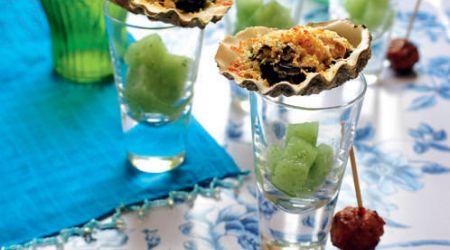Oysters
As our wintry coastal waters yield up their treasures, Helen Hokin prises open the secrets of Britain’s precious pearly kings with recipes by Linda Tubby
‘Possibly the best thing to come out of Britain,’ enthused the Roman general (and, briefly, emperor) Vitellius on tasting oysters from the Essex Blackwater River during the first century AD. He would summon slaves bearing snow-lined baskets of delectable Colchester and Whitstable Native oysters across Europe to his HQ, where he would pop them with an abandon usually reserved for grapes. Throughout the ages, the oyster has fed rich and poor alike. A glut in the late 1200s saw prices plummet to two pence a gallon, making them an affordable food even for the least well off; in Elizabethan times they were a popular staple on fish-eating days, while fine diners used them as palate cleansers between courses. In the late 1800s it seems the entire western world was in the grip of an oyster-eating frenzy; from the Thames estuary to New York, everyone was slurping cold oysters from the half shell.
Vitellius was right about our Native flat oysters; the smooth, pinky-coloured, fan-shaped shells loaded with firm, delicate meat are the glory of Britain and the envy of the rest of the oyster-producing world. According to the UK Shellfish Association, in 2007 producers enjoyed the highest demand ever recorded for the pearly aristocrats of the sea. Both Colchester and Whitstable Natives (as opposed to the long, grey-shelled Pacific variety also cultivated in the UK) have been thriving for millennia in the plankton-rich waters of the Mersea Island creeks off Essex and along the Whitstable flats in Kent. Their unbeatable taste and texture keeps business buoyant. For the past 200 years, for example, the Haward family has harvested a 120-hectare patch encompassing the historic Blackwater River and Mersea Island creeks.
Today’s oyster boats have engines rather than sails and the dredging up of oysters is mechanised rather than manual, but other than that, the process of taking these prize molluscs from sea to market has barely changed. It works like this: after four years in their natural habitat, Native oysters are dredged from the deep salty water and relocated to shallow, marshy creeks. They’re re-laid for at least another year on glorious mud, fattening up and filtering the nutrient-rich water that gives them their unique flavour. Colchester Natives are slightly salty with a unique iodine note. Their marshy home lends some of them a natural green hue – which leaves the French the same colour with envy (they have been known to introduce a similar tinge to their own Belon Natives by means of artificial colourings). Finally they are dredged, hand-sorted, purified in clear water for 48 hours and sent to market.
Just along the coastline the equally delectable Whitstable Native is less saline than its Colchester counterpart with a uniform whiteness – it’s entirely subjective, but some Brits prefer them that colour.
The Pacific is Britain’s adopted oyster. Cultivated widely around our coastline, it was introduced when the Native twice suffered near extinction – once from harsh frost in 1963, and again in 1980 when bonamiasis, an oyster-killing disease, almost wiped it out. Pacifics are hardier and more resistant to disease, as well as being faster growers. Although their flesh is a touch less firm and their taste not as subtly mineral-like, they are a perfectly acceptable (and affordable) alternative. The current going rate for a dozen Pacifics averages £12, while the same number of Natives weigh in at £20. Natives can also be hard to come by whereas Pacifics are readily available.
Pacifics are harvested in Essex, Kent, Poole, south Devon, Cornwall and abundantly on the west coast of Scotland. Unlike Natives, which might take all of seven years to reach optimum growth and flavour, Pacifics are ripe and ready after just three. They keep our restaurants and markets brimming. And as for not eating oysters when there isn’t an ‘r’ in the month, by some ancient law Native flat oysters cannot be sold during the months of May, June, July and August when they are spawning. But for those of us who, like Vitellius, just can’t get enough, Pacifics (because they are grown artificially) are available all year round.
Whichever variety you choose, there is only one way to open them – carefully. Hold the oyster, cup-side down, in the palm of your hand. Point the hinged edge towards you. Using an oyster knife slide the blade between the join where the two shells meet and gently prise and twist. Run the knife between the inside edge of the shells to cut through the muscle holding them together. Slide the knife under the oyster meat to separate it from its shell. Keep the shell level all the time, or risk watching its precious juices run away. Eat them as soon as you open them. Never store them in water or in too cold a fridge, as they will die.
A dozen oysters on a plate of ice is about as good as it gets. Have a glass of champagne, Guinness or Chablis at the ready, as well as your favourite accompaniment – the Victorians liked the fashionable exoticism of cayenne pepper and the Edwardians went for shallot vinegar. However, I reckon a certain Roman emperor and his countrymen had it right – a simple squeeze of lemon is the most elegant way to go. After all those years spent plumping up on the seabed, to swallow the sumptuous morsels without savouring them is bordering on sinful. Hold for a second or two between the tongue and the roof of the mouth and crush, gently, until the rush of briny juice floods your taste buds with the tang of the sea.

Recipes
Get Premium access to all the latest content online
Subscribe and view full print editions online... Subscribe



